

Athens
Delphi
Corinth
Santorini
Click a link or read the full details in the posts below.
Murray & Christine's record of their journey. "A day in a car in an English county is a trip to a fairy museum where all the exhibits are live and real." Rudyard Kipling
 An early morning start was needed to catch the 7 a.m. ferry to Athens. The wind on the island was quite fierce and the weather during the trip was very indifferent: there was no incentive whatsoever to venture out on deck.
An early morning start was needed to catch the 7 a.m. ferry to Athens. The wind on the island was quite fierce and the weather during the trip was very indifferent: there was no incentive whatsoever to venture out on deck. Arriving in Athens the sky did not look much better but by the time we had caught the Metro to our hotel, checked in and used the rest of our 90-minute ticket to get to the Acropolis station, the sun was shining quite brightly.
Arriving in Athens the sky did not look much better but by the time we had caught the Metro to our hotel, checked in and used the rest of our 90-minute ticket to get to the Acropolis station, the sun was shining quite brightly. and converted Dionysios, (v34) who later became the patron saint of Athens, to the Christian religion.
and converted Dionysios, (v34) who later became the patron saint of Athens, to the Christian religion. After that it was time to meander through the pedestrianised streets in Plaka, the tourist-trap part of the city, then head back to our hotel for another of their wonderful Greek Salads. At least one of us had a Greek Salad every night during our stay in Greece and the best by far were those served at the Hotel Rio.
After that it was time to meander through the pedestrianised streets in Plaka, the tourist-trap part of the city, then head back to our hotel for another of their wonderful Greek Salads. At least one of us had a Greek Salad every night during our stay in Greece and the best by far were those served at the Hotel Rio. An interesting feature of travelling on the Metro in Athens is the amount of marble in the stations: whether this is a result of the 2004 Olympics or not, I do not know. There are also a number of stations where ruins were found while excavating for the stations. A very interesting one is Monastiraki station where the remains of an old river containment scheme were discovered.
An interesting feature of travelling on the Metro in Athens is the amount of marble in the stations: whether this is a result of the 2004 Olympics or not, I do not know. There are also a number of stations where ruins were found while excavating for the stations. A very interesting one is Monastiraki station where the remains of an old river containment scheme were discovered. Today was a clear blue-sky day when we surfaced, the first such morning on the island. Since we had extended our car hire for another morning we set off for the archaeological site at Akrotiri, which is supposed to be one of the finest Minoan sites in the area; however, it was closed for "technical reasons".
Today was a clear blue-sky day when we surfaced, the first such morning on the island. Since we had extended our car hire for another morning we set off for the archaeological site at Akrotiri, which is supposed to be one of the finest Minoan sites in the area; however, it was closed for "technical reasons". We had decided on this walk having read in a section on Oia that "a marble-paved walkway skirts the edge of the caldera to Fira" (Eyewitness Travel Guide: 'The Greek Islands', 2003): the author of the guide had obviously never walked this marble-paved path. A couple of hundred metres leading out of Oia is indeed a fabulous marble-paved walkway but the rest, between Oia and Imerovigli is neither marble nor paved in places.
We had decided on this walk having read in a section on Oia that "a marble-paved walkway skirts the edge of the caldera to Fira" (Eyewitness Travel Guide: 'The Greek Islands', 2003): the author of the guide had obviously never walked this marble-paved path. A couple of hundred metres leading out of Oia is indeed a fabulous marble-paved walkway but the rest, between Oia and Imerovigli is neither marble nor paved in places. Shops that had been open on our two previous visits were now all closed and the streets were practically deserted. The difference: no cruise liners moored near Fira. So we enjoyed Oia in the sunshine with the views, streets and photographic vantage points pretty much to ourselves and the hard-working load bearing donkeys. There are advantages and disadvantages of visiting Santorini in the off-season, not too hot, not crowded but many businesses are closed.
Shops that had been open on our two previous visits were now all closed and the streets were practically deserted. The difference: no cruise liners moored near Fira. So we enjoyed Oia in the sunshine with the views, streets and photographic vantage points pretty much to ourselves and the hard-working load bearing donkeys. There are advantages and disadvantages of visiting Santorini in the off-season, not too hot, not crowded but many businesses are closed.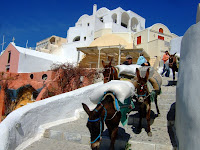 They are quite imposing and clearly much larger than the surrounding houses and of quite a different and distinct architectural style. With a spare €400 - €500,000 you can buy a derelict one - not on the caldera side with the great views - and providing you have another €150 - €200,000 to spend on renovating it, you can have yourself a lovely home on a Greek Island. Oia is, apparently, the most expensive real estate in Greece. There is one ruin there currently that is on the market for a mere €750,000: we were not tempted.
They are quite imposing and clearly much larger than the surrounding houses and of quite a different and distinct architectural style. With a spare €400 - €500,000 you can buy a derelict one - not on the caldera side with the great views - and providing you have another €150 - €200,000 to spend on renovating it, you can have yourself a lovely home on a Greek Island. Oia is, apparently, the most expensive real estate in Greece. There is one ruin there currently that is on the market for a mere €750,000: we were not tempted. The local bus returned us to Fira where, in the absence of yesterday's sea-fog, we thought we may get one of the fabled Santorini sunset shots, but although the sky was clear the bank of cloud on the horizon prevented any colour at all as the sun set.
The local bus returned us to Fira where, in the absence of yesterday's sea-fog, we thought we may get one of the fabled Santorini sunset shots, but although the sky was clear the bank of cloud on the horizon prevented any colour at all as the sun set.
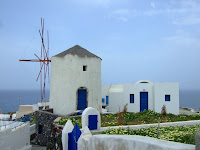 gloomy and overcast after a very windy night but then the sun broke through so we decided to extend the hire on the car and set off once again for Oia. By the time we arrived the sun was shining brightly on the houses making the village sparkle in the sunlight. We had an enjoyable time exploring much more of the village than we did yesterday, as well as exploring the two harbours at the foot of the cliffs.
gloomy and overcast after a very windy night but then the sun broke through so we decided to extend the hire on the car and set off once again for Oia. By the time we arrived the sun was shining brightly on the houses making the village sparkle in the sunlight. We had an enjoyable time exploring much more of the village than we did yesterday, as well as exploring the two harbours at the foot of the cliffs. Returning to Fira, Christine descended the 580 steps to the fishing village below and we both rode the cable car back up to the top. The cable car was a gift to the island community from a wealthy Greek shipping magnate.
Returning to Fira, Christine descended the 580 steps to the fishing village below and we both rode the cable car back up to the top. The cable car was a gift to the island community from a wealthy Greek shipping magnate. A significant proportion of the morning was taken up with the hunt for a photo location. Many of the books about Santorini, and in fact, many of the books about the Greek Islands in general, feature two particular churches. We had located one in Oia but the other had eluded us. The books were not helpful in that they did not identify the location
A significant proportion of the morning was taken up with the hunt for a photo location. Many of the books about Santorini, and in fact, many of the books about the Greek Islands in general, feature two particular churches. We had located one in Oia but the other had eluded us. The books were not helpful in that they did not identify the location 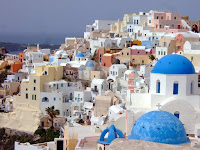 of their cover shot, however we came across a postcard that included not only the elusive church but the three islands in the caldera. Using our map and the relative positions of the islands in the postcard we were able to work out the position of the church fairly accurately: it was in Firostefani. It transpired we had walked along the cliff path beneath it on our first day but had not realised that it was just above us at the time.
of their cover shot, however we came across a postcard that included not only the elusive church but the three islands in the caldera. Using our map and the relative positions of the islands in the postcard we were able to work out the position of the church fairly accurately: it was in Firostefani. It transpired we had walked along the cliff path beneath it on our first day but had not realised that it was just above us at the time.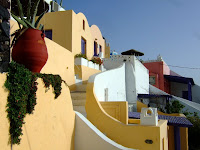 As the sky had steadily got clearer through the day, we had high hopes of magnificent sunset shots from Oia so, late in the afternoon, we set off to the northern end of the island once again. As we drove along we could see what looked like a roll of cotton wool out to sea and this rolling sea fog rapidly engulfed us, and the island ahead. So much for sunsets, there was no point in proceeding and by the time we had returned to Fira it, too, was shrouded in the sea fog.
As the sky had steadily got clearer through the day, we had high hopes of magnificent sunset shots from Oia so, late in the afternoon, we set off to the northern end of the island once again. As we drove along we could see what looked like a roll of cotton wool out to sea and this rolling sea fog rapidly engulfed us, and the island ahead. So much for sunsets, there was no point in proceeding and by the time we had returned to Fira it, too, was shrouded in the sea fog. After an early morning stroll through Fira to the northern end of the suburb that adjoins it we returned to our Hotel and rented a car from a nearby car rental firm. Car and motorbike/quad-bike rental firms are everywhere on the island, although like many other businesses in this off-season period, most are closed. Car rental seems very good value, presumably because there is no way that you can drive hundreds of kilometres before you return is as the island is not very big.
After an early morning stroll through Fira to the northern end of the suburb that adjoins it we returned to our Hotel and rented a car from a nearby car rental firm. Car and motorbike/quad-bike rental firms are everywhere on the island, although like many other businesses in this off-season period, most are closed. Car rental seems very good value, presumably because there is no way that you can drive hundreds of kilometres before you return is as the island is not very big. Leaving Fira we went east, past the airport to one of the sandy beaches on the east coast, Monolithos. We then drove down the coast to Kamari, another beach resort and then on to Ancient Thira.
Leaving Fira we went east, past the airport to one of the sandy beaches on the east coast, Monolithos. We then drove down the coast to Kamari, another beach resort and then on to Ancient Thira.  First settled in 9 BC this ruined city is on commanding hilltop site 370m above the sea. A series of 24 switchback turns takes the braver driver to within a few metres of the top, leaving only a short climb to the extensive ruins.
First settled in 9 BC this ruined city is on commanding hilltop site 370m above the sea. A series of 24 switchback turns takes the braver driver to within a few metres of the top, leaving only a short climb to the extensive ruins. We retraced our route down the 24 switchbacks then headed across to the western side of the island and visited Pyrgos, which, according to the guidebooks is one of the more attractive villages on Santorini. Frankly, we were not convinced. Through Megalochiori and towards Akrotiri we passed through the grape growing area of Santorini
We retraced our route down the 24 switchbacks then headed across to the western side of the island and visited Pyrgos, which, according to the guidebooks is one of the more attractive villages on Santorini. Frankly, we were not convinced. Through Megalochiori and towards Akrotiri we passed through the grape growing area of Santorini 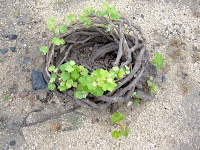 where the vines are intriguingly trained into coils on the ground as protection against the wind.
where the vines are intriguingly trained into coils on the ground as protection against the wind.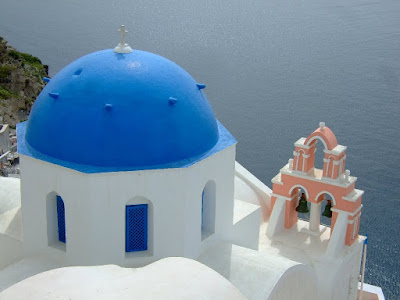
 At 06:05 our taxi had not appeared so when another cruising taxi enquired if we wanted a ride we accepted. The traffic was light and we were at the ferry far too early but that was far better than missing the boat.
At 06:05 our taxi had not appeared so when another cruising taxi enquired if we wanted a ride we accepted. The traffic was light and we were at the ferry far too early but that was far better than missing the boat.  After 4 hour's cruising we arrived at Paros and after a short stop we were off again bound for Naxos then Ios before finally arriving at Santorini at 4pm.
After 4 hour's cruising we arrived at Paros and after a short stop we were off again bound for Naxos then Ios before finally arriving at Santorini at 4pm. the summer crowds and were taken up the switchback road from the port to Fira, the main town on the island.
the summer crowds and were taken up the switchback road from the port to Fira, the main town on the island.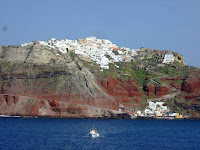 After locating our accommodation we wandered to the top of Fira, past the terminal for the recently built cable car and then found a restaurant for dinner.
After locating our accommodation we wandered to the top of Fira, past the terminal for the recently built cable car and then found a restaurant for dinner.

 (Acts 18:1) and, since the next most popular day trip from Athens is to Corinth, we decided to follow Paul's example. The buses to Corinth leave from Terminal A and the local bus to Terminal A went right past our Hotel. All in all it seemed a promising start. We left the Hotel and walked to the corner where the bus stop was, stopping at the street kiosk to buy a bus ticket. "Sorry, no ticket." A quick jog back to the Hotel to check where we could purchase a bus ticket, only to be pointed back to the kiosk I had just left. No matter, there were plenty more kiosks in the locality. Sorry-no-ticket-kiosk four suggested I try the Metro station but the door to the Metro was closed. Optimistically, I crossed the road to the other Metro entrance, also barred: this was getting serious. Finally I managed to encourage a lady in a mini-market to leave her conversation and return to her counter and sell me the needed bus tickets.
(Acts 18:1) and, since the next most popular day trip from Athens is to Corinth, we decided to follow Paul's example. The buses to Corinth leave from Terminal A and the local bus to Terminal A went right past our Hotel. All in all it seemed a promising start. We left the Hotel and walked to the corner where the bus stop was, stopping at the street kiosk to buy a bus ticket. "Sorry, no ticket." A quick jog back to the Hotel to check where we could purchase a bus ticket, only to be pointed back to the kiosk I had just left. No matter, there were plenty more kiosks in the locality. Sorry-no-ticket-kiosk four suggested I try the Metro station but the door to the Metro was closed. Optimistically, I crossed the road to the other Metro entrance, also barred: this was getting serious. Finally I managed to encourage a lady in a mini-market to leave her conversation and return to her counter and sell me the needed bus tickets. Arriving at Terminal A we located the counter which sold tickets to Corinth (they seem to have one ticket selling counter and agent per destination) and noted that the next bus was scheduled to leave in 10 minutes. No particular problem there except that the agent was on the phone to his broker/wife/mistress/bookie/whatever and was not going to interrupt his important call for a couple of tourists. As the time ticked past 4 minutes to go I began tapping on my watch meaningfully, but the phone call continued. This was particularly worrying, as yesterday's bus to Delphi had left 3 minutes before the scheduled time. Finally, right on the departure time the agent finished his call; put in a quick call to the controller on the platform; sold us the tickets; and told us we needed to hurry: something we had been trying to tell him for the past 10 minutes!
Arriving at Terminal A we located the counter which sold tickets to Corinth (they seem to have one ticket selling counter and agent per destination) and noted that the next bus was scheduled to leave in 10 minutes. No particular problem there except that the agent was on the phone to his broker/wife/mistress/bookie/whatever and was not going to interrupt his important call for a couple of tourists. As the time ticked past 4 minutes to go I began tapping on my watch meaningfully, but the phone call continued. This was particularly worrying, as yesterday's bus to Delphi had left 3 minutes before the scheduled time. Finally, right on the departure time the agent finished his call; put in a quick call to the controller on the platform; sold us the tickets; and told us we needed to hurry: something we had been trying to tell him for the past 10 minutes! We collapsed into our seats for the journey to modern Corinth, crossing the Corinth Canal, cut over 90m into solid rock. First suggested in 6BC it was begun by Nero in 67AD and finished by French engineers 1826 years later.
We collapsed into our seats for the journey to modern Corinth, crossing the Corinth Canal, cut over 90m into solid rock. First suggested in 6BC it was begun by Nero in 67AD and finished by French engineers 1826 years later. The local bus dropped us back in the centre of modern Corinth but it appeared that the bus back to Athens did not collect from there and we had to walk back to the bus station. Fortunately we had time before the next scheduled departure, but it did seem a very strange arrangement. As we approached Athens we were caught in a traffic jam and crawled along for some time, broken only by a slanging match between the passengers and driver. They were all quite voluble with their various opinions and it was a pity that it was all Greek to us: we did pick out the word 'Metro' a few times.
The local bus dropped us back in the centre of modern Corinth but it appeared that the bus back to Athens did not collect from there and we had to walk back to the bus station. Fortunately we had time before the next scheduled departure, but it did seem a very strange arrangement. As we approached Athens we were caught in a traffic jam and crawled along for some time, broken only by a slanging match between the passengers and driver. They were all quite voluble with their various opinions and it was a pity that it was all Greek to us: we did pick out the word 'Metro' a few times. Finally, the passengers in the know started to assemble their coats and bags so we assumed we were nearly back to Terminal A, however the bus just pulled to the side of the road and the passengers started to disembark. Looking out the window I realised I was looking down the street to our Hotel so we quickly joined the exodus.
Finally, the passengers in the know started to assemble their coats and bags so we assumed we were nearly back to Terminal A, however the bus just pulled to the side of the road and the passengers started to disembark. Looking out the window I realised I was looking down the street to our Hotel so we quickly joined the exodus. Later that evening the general strike struck again. The electricity was turned off for 90 minutes, just as we were beginning to pack our bags for our early morning start. Fortunately the laptop had a full charge and there was enough illumination from the screen to see what we were doing, although we did abandon packing and used the light to get ourselves to bed, instead.
Later that evening the general strike struck again. The electricity was turned off for 90 minutes, just as we were beginning to pack our bags for our early morning start. Fortunately the laptop had a full charge and there was enough illumination from the screen to see what we were doing, although we did abandon packing and used the light to get ourselves to bed, instead.